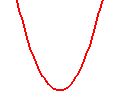|
Question 1187396: Question 3.7/12
Let f(x)=(x+1)2
Give the largest domain on which f is one-to-one and non-decreasing=
Give the range of f=
Find the inverse of f restricted to the domain above f-1(x)=
Give the domain of f-1 =
Give the range of f-1=
Answer by KMST(5328)   (Show Source): (Show Source):
You can put this solution on YOUR website! The function  is a quadratic function, meaning a polynomial function of degree 2. is a quadratic function, meaning a polynomial function of degree 2.
Those functions have graphs like this  or the same curve upside down. or the same curve upside down.
They are symmetrical with a vertex that is a maximum or minimum, separating a decreasing branch from an increasing branch.
You realize that for  , ,  and and  , but for any other number , but for any other number  . .
The graph decreases from any value of  , and increases for , and increases for  . .
The largest domain on which f is one-to-one and non-decreasing is [-1,infinity), or  . .
The range is [0,infinity), because  , and for , and for  it increases without bounds. it increases without bounds.
To find the inverse we swap  and and  in the function defined as in the function defined as  only when only when  <--> <--> , and solve for , and solve for 
we get  for for  , whose solution is , whose solution is  <--> <-->  . .
The inverse function is   for for  . .
  has domain [0,infinity) or has domain [0,infinity) or  and range [-1,infinity) or and range [-1,infinity) or 
The domain of an inverse function is the range of the domain-restricted function, and the range of the inverse is the restricted dominion.
|
|
|
| |